Hamster Weirdness: 13 Hamster Behaviors Explained
A hamster’s behavior can often be baffling to their owners. Why do they constantly chew? Why do they hoard food? And why do they sometimes seem scared of their own shadow? Weirdness?
Let’s explore 13 common hamster behaviors and try to explain what’s going on behind them. From standing up to chewing on bars, read on to learn more about your furry friend.
1. Burrowing – Is It Normal? Do I Need to Worry?
Hamsters are burrowing animals by nature. In the wild, they live in underground burrows where they are protected from predators and the elements. Domestic hamsters also like to burrow, and it’s a natural behavior that you shouldn’t try to stop.
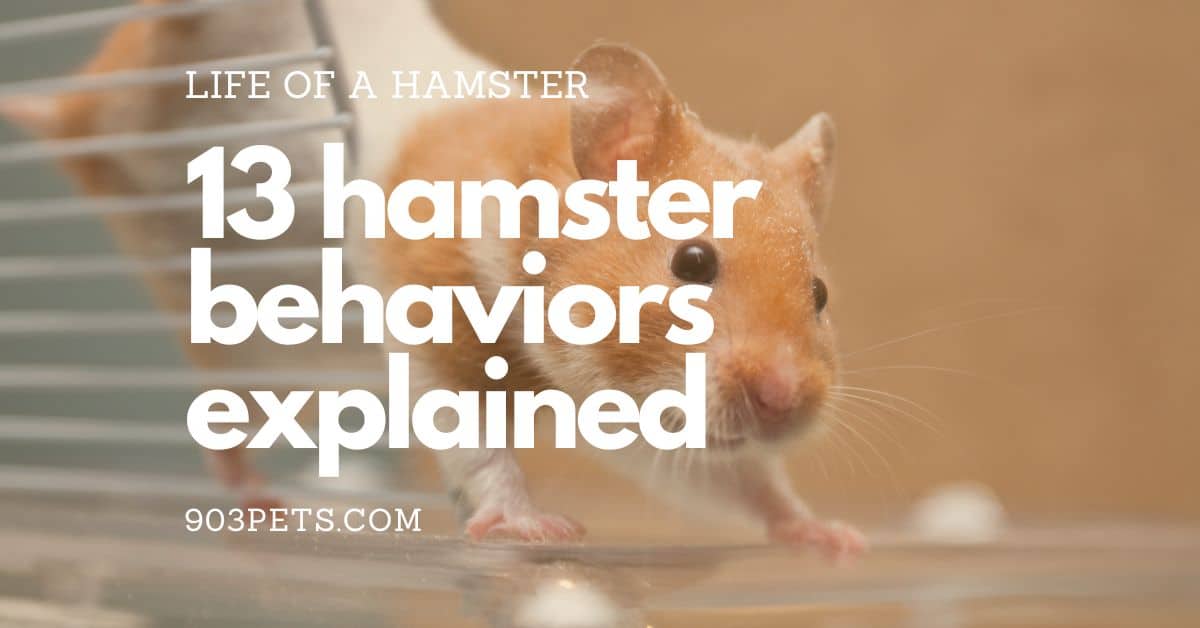
Burrowing is instinctive for hamsters, and it gives them a sense of security. If your hamster is burrowing a lot, it may be because he feels anxious or stressed. If you think this is the case, try adding more hiding places and toys to his cage so he feels more secure.
Our Pick For Best Hamster Bedding
Studies and research suggest that paper bedding is best for our hammies. The Carefresh natural paper bedding for small animals is our top pick to use, today.
What We Like:
- Natural paper bedding
- 99% dust free – Reduced cause of respiratory issues for hamsters and human in some cases.
- Up to 10 Days of ammonia odor control
- Good for tunneling and burrowing
- Reduced chance for cuts from sharp portions
- Good absorbency

You don’t need to worry about your hamster’s burrowing behavior, but you should make sure his cage has plenty of bedding material for him to tunnel through.
Most pet owners do not need to worry about their hamster’s burrowing behavior. However, if your hamster is burrowing excessively, it may be a sign of stress or illness. If you are concerned about your hamster’s health, consult with a veterinarian.
2. Hoarding – A Hamster Reality TV Show?
Hoarding is a common behavior in hamsters, and is characterized by the animal collecting and storing large amounts of food or other items.
This behavior is most often seen in wild hamsters, who need to store up supplies for the winter months. However, hoarding can also be seen in pet hamsters, who may hoard their food because they are unsure when their next meal will be.
Hoarding behavior can be normal in some cases as it’s a part of their instinct however if you see your hamster obsessively gathering food and not eating it or playing with it, this could be a sign of something more serious like pica.
Pica is the fancy scientific term for when an animal eats things other than food, like bedding or their poop. This may be a sign of digestive or stomach issues.
If your hamster is exhibiting any other strange behaviors along with hoarding, it’s best to take them to the vet for a check-up.
3. Chewing – More Than A Mouthful
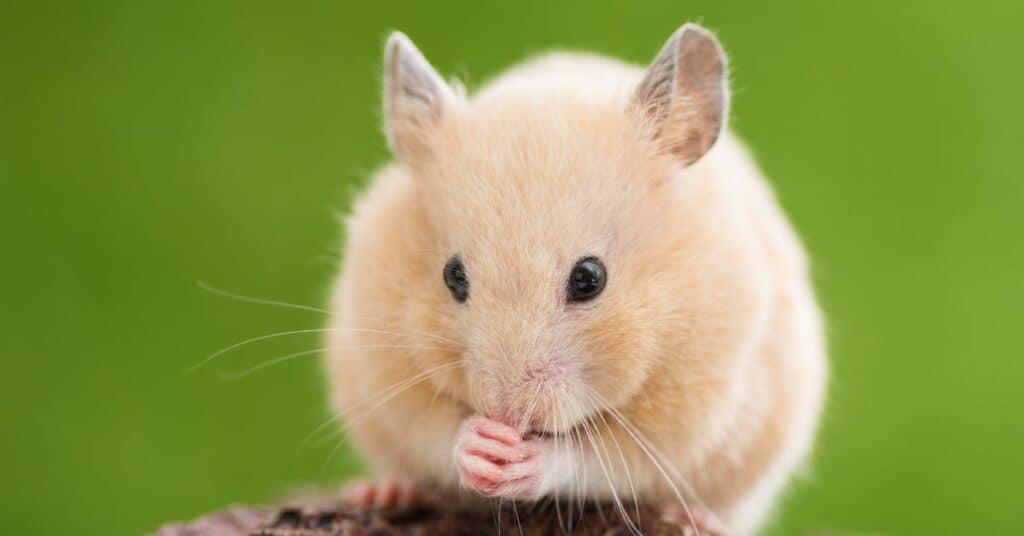
If you’ve ever wondered why your hamster is constantly chewing, you’re not alone. Chewing is a common behavior for hamsters, and there are a few different reasons why they do it.
For one, chewing helps keep their teeth healthy and sharp. Hamsters have a lot of teeth, and if they didn’t chew on things, their teeth would get too long. Chewing also helps them relieve boredom or stress.
If your hamster is constantly chewing on their cage bars, it might be a sign that they’re bored and need more toys or attention or its cage is too small.
Finally, some hamsters simply enjoy the taste or texture of certain things. If your hamster is constantly chewing on their bedding, it’s probably because they like the way it feels or tastes.
But why do hamsters chew on bars? There are a few different reasons.
One reason is that it helps keep their teeth healthy and clean. Hamsters have very sharp teeth that grow continuously throughout their lifetime. Chewing on bars helps wear down their teeth so they don’t get too long.
Another reason why hamsters chew on bars is that it’s a way for them to relieve boredom or stress. If a hamster isn’t getting enough mental stimulation, they may start chewing on cage bars as a way to entertain themselves.
4. Pouncing – Hamster or Cat
Hamsters are known for being playful and active, and one of their favorite activities is pouncing. Pouncing is when a hamster jumps up into the air and comes down on its hind legs, often with its front paws outstretched. It’s a way for hamsters to release energy, explore their surroundings, and have fun.
Pouncing can also be a sign of excitement or happiness. If you see your hamster pouncing around its cage, it’s likely because it’s happy and content. However, if your hamster is pouncing excessively or aggressively, it may be a sign of stress or boredom. In these cases, try providing your hamster with more toys and enrichment items to keep it entertained.
5. Climbing – Free Climbing The North Face
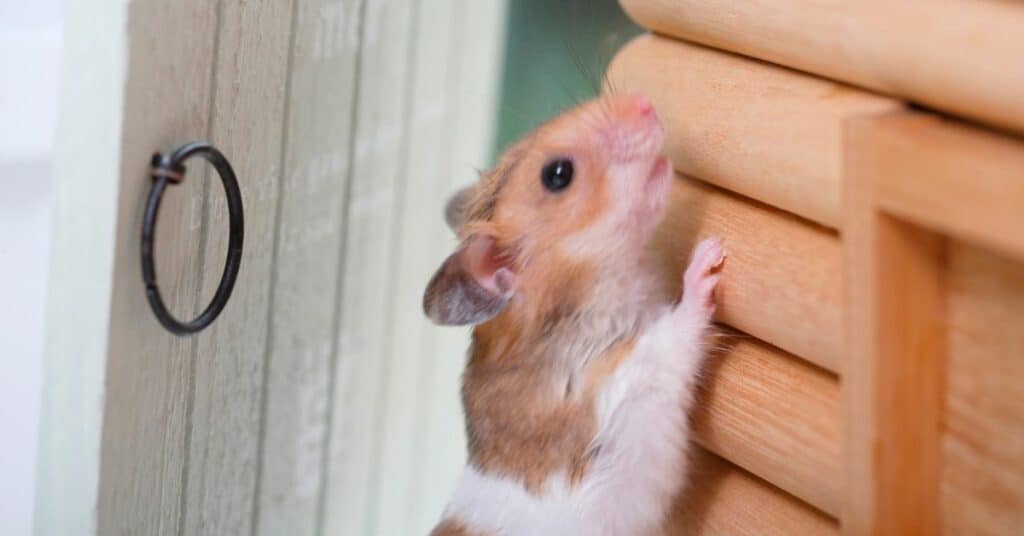
Climbing is a common behavior for hamsters, and there are a few reasons why they might do it. One reason is that they’re simply trying to get to a higher place.
Hamsters are naturally curious creatures, and they want to be able to see everything that’s going on around them. If there’s something interesting up high, they’ll want to check it out.
Another reason hamsters climb is because they’re looking for a way to escape. If their cage isn’t big enough or if they’re not getting enough stimulation, they might try to climb out in order to find a better environment.
Finally, climbing can also be a sign of boredom or stress. If your hamster is climbing more than usual, it might be an indication that something needs to change in their routine.
But be careful. Hamsters are fragile creatures and a fall from a height could become fatal or cause injury .
The best way to keep your hamster from climbing is to limit its access to areas that could be dangerous. They shouldn’t have any reason to climb, so it’s important to make sure they have all the stimulation and comfort they need in their cage.
6. Food In Cheek Pouches – Saving For A Rainy Day
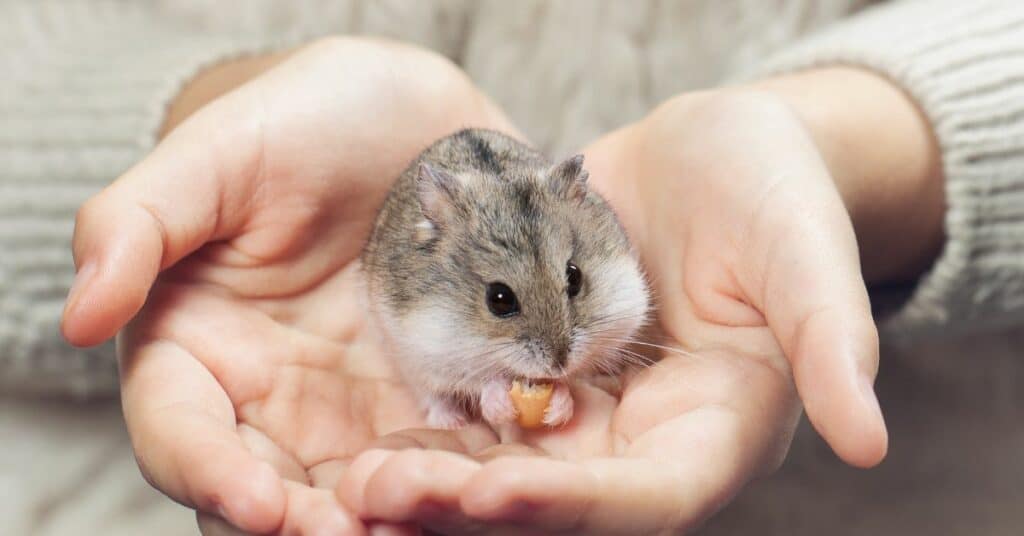
Cheek pouches are one of the most distinctive features of hamsters. These pockets on either side of the face allow hamsters to stuff their cheeks with food and then take it back to their burrows to eat later.
Hamsters typically fill their cheek pouches with as much food as they can before returning to their homes. This behavior is known as hoarding, and it helps hamsters survive during times when food is scarce.
While this behavior may seem odd to us, it is actually quite natural for hamsters.
But, when does this behavior become a concern? In short, on rare occasions, food or things other than food, might become lodged in the cheek pouches. This is called a cheek pouch impaction, and it is a potentially serious condition.
How do you know if my hamster has a cheek pouch impaction? If you notice your hamster is not eating normally or it seems to have trouble chewing, this could be a sign of a cheek pouch impaction. A visit to the vet would certainly be in order.
7. Digging – All The Way To China
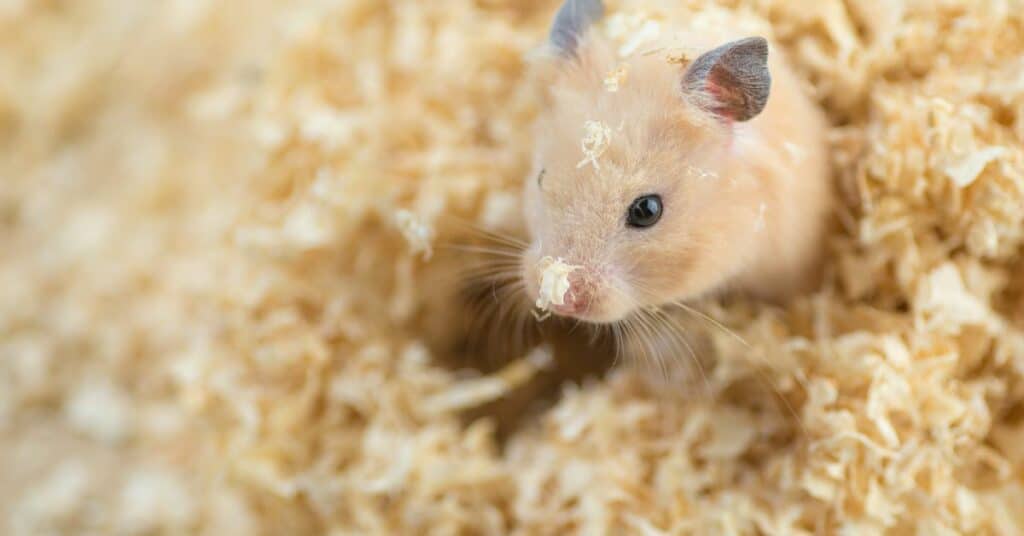
When your hamster is busy digging, they are usually trying to create a burrow. This is an instinctive behavior that comes from their wild ancestors. By replicating this behavior in captivity, your hamster feels more comfortable and secure.
If you provide your hamster with plenty of bedding material, they will likely build themselves a small nest in which to sleep. The nesting material also provides insulation against the cold and acts as a cushion in case of falls.
Hamsters are nocturnal animals, so they do the majority of their digging at night. This can be disruptive to your sleep if you have your hamster’s cage in your bedroom. So, just be aware that this is natural behavior, and if your hamster is making a lot of noise at night, don’t be startled.
8. Scratching – Itchy, Scratchy, Oh My
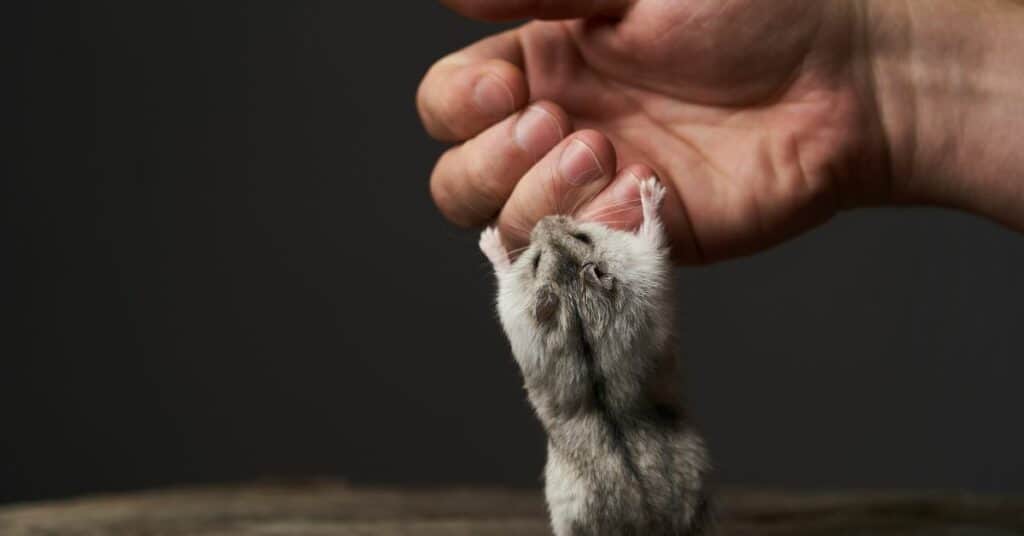
Hamsters love to scratch themselves! It helps them keep their fur clean and free of knots. If you see your hamster scratching a lot, it’s probably because they’re trying to get rid of fleas or other parasites.
Scratching is also a way for hamsters to mark their territory. They have scent glands in their hindquarters or belly that release pheromones, which help claim their space and let other hamsters know where they’ve been.
So if you see your furry friend scratching away, don’t be too alarmed. It’s just their way of keeping clean and making sure everyone knows who’s boss!
However, if the scratching is less grooming in nature and more relief control, then your hamster could have fleas. If this is the first time you are dealing with fleas on a hamster, we recommend visiting the vet.
Your vet will probably recommend applying a special flea spray to your hamster and its environment, which you can use in the short term.
Speak with a veterinarian before applying any flea treatment product to your hamster! Some flea treatments are appropriate for animals, but not suitable for hamsters.
9. Sleeping During The Day – Like A Teenager
Sleeping during the day is one of the most common hamster behaviors. Hamsters are thought of as nocturnal creatures, however, they are actually crepuscular. This means that they are most active at dawn and dusk. So, during the day, they sleep for long periods of time. This behavior is perfectly normal and nothing to worry about.
However, there are some exceptions to this rule. Some hamsters may be diurnal, meaning they are active during the day and sleep at night. This is more common in pet hamsters than wild hamsters.
The reason for this difference is unknown, but it may have to do with the fact that pet hamsters are often kept in cages with artificial light. This can disrupt their natural sleep cycles and cause them to be active during the day instead of at night.
If you notice your hamster sleeping significantly more during the night and day than usual and generally lethargic, it could be a sign that something is wrong. For example, if your hamster is sick or in pain, it may sleep more during the day to conserve energy. If you think your hamster may be sick, contact a veterinarian immediately.
In general, however, there is no need to worry if your hamster is sleeping during the day. They will likely be up and running around their cage at night when you’re asleep!
10. Squeaking – Keep Your Hands In The Ride At All Times
Few things are as cute as a hamster squeaking, but have you ever wondered why they do it? Here are some possible explanations for this common behavior.
One reason your hamster may be squeaking is to get your attention. If you’ve been ignoring your furry friend, they may start making noise in order to get you to interact with them. This is especially common if your hamster is used to being handled and played with regularly.
Another possibility is that your hamster is bored and wants something to do. If they’re stuck in their cage with nothing to do, they may start making noise out of sheer boredom. Try giving them more toys and activity opportunities to see if that quiets them down.
Finally, some hamsters squeak or make hissing sounds as a sign of aggression or fear. If your hamster is hissing at you, it may not be the best idea to reach in and try to pet it.
11. Licking – Sweet or Salty
You may have noticed your hamster licking various objects including themselves, their cage, and you. But what does this mean?
Licking is a way for hamsters to explore their environment and get information about their surroundings. When they lick you, it’s likely because you smell interesting to them or they want to show affection.
Licking their cage is usually done for one of two reasons: either they’re trying to clean it or there’s something salty or sweet that they’re tasting.
As for licking themselves, this is part of their grooming routine. Hamsters need to keep their fur clean and free of debris so that they can stay warm and avoid getting sick.
12. Standing on Hind Legs – Raise The Flag
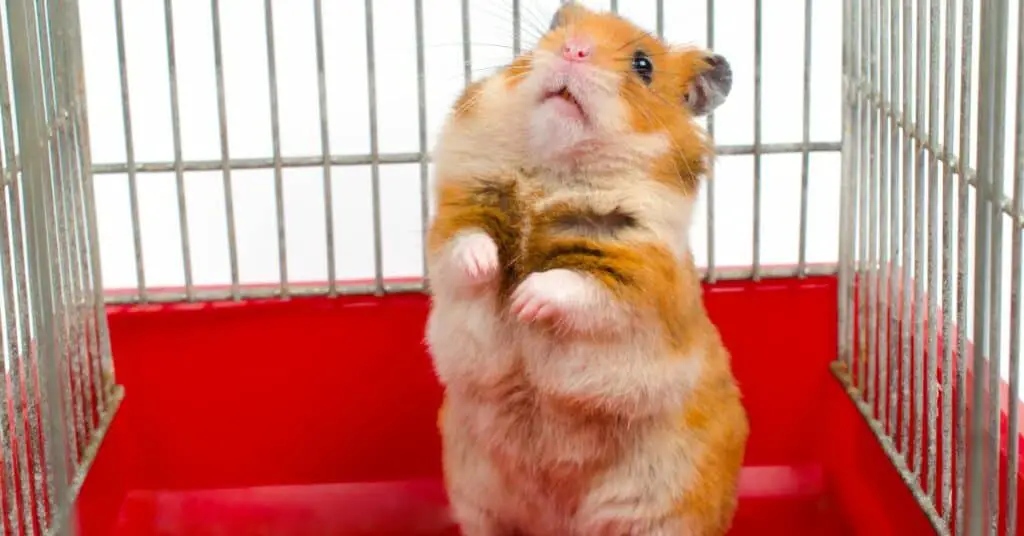
One of the most common and adorable hamster behaviors is standing on their hind legs. This behavior is often seen when hamsters are exploring their environment or trying to get a better view of something.
While it may look like they’re just showing off, this behavior also serves an important purpose for hamsters. By standing on their hind legs, hamsters are able to see and smell things that they wouldn’t be able to detect from the ground. This helps them stay aware of potential predators or other environmental dangers.
Another reason why hamsters stand on their hind legs is to beg for food. If you’ve ever given your hamster a treat, you may have noticed that they quickly stand up on their back legs in anticipation. This begging behavior is usually accompanied by cute little squeaks and gestures that are hard to resist!
Finally, standing on their hind legs also helps hamsters stay alert and aware of potential threats. By being up high, they can see anything that might be coming toward them and be ready to defend themselves if necessary.
However, if your hamster starts standing on its hind legs more often than usual, it could be a sign that something is wrong. For example, if your hamster suddenly starts standing on its hind legs and looking around constantly, it might be ill or in pain. If this happens, take your hamster to the vet as soon as possible.
13. Rubbing Backside or Belly On Things – No Twerking Zone
One common hamster behavior is rubbing their backside or belly on things. This is usually done to mark their territory, but it can also be a way of showing affection. Hamsters have special scent glands on their backside or belly, depending on the species.
They rub these areas on things like the sides of the cage or even your hand to leave their scent. Some hamsters will also rub their backside on you if they are showing affection. This is a good sign.
If your hamster rubs up against you, it may be a sign that they consider you to be part of their pack. Welcome to the club. You’ve been accepted. 🙂
Another reason why hamsters may rub their belly on things is to relieve itchiness. If your hamster is constantly scratching themselves, it could be a sign that they have fleas or other parasites. In this case, you should take them to the vet for treatment.
What We Learned
In this lesson, we learned that hamsters are interesting creatures and can exhibit some weird behaviors. While many of these behaviors have natural explanations, some can be signs of problems. If you notice any of the weird behaviors we talked about, you should take your hamster to the vet for a checkup.
Otherwise, just enjoy learning and watching your little hammy be its unique, weird self. We love our hammies, don’t we?!?!
If you think your pet is ill, call a vet immediately. All health-related questions should be referred to your veterinarian. They can examine your pet, understand its health history, and make well informed recommendations for your pet.
903pets.com Staff


![Hamster Escaped - Where To Find A Lost Hamster Indoors Fast [Statistics] 9 where to find a lost hamster indoors](https://cdn-0.903pets.com/ifywhoft/2022/02/where-to-find-a-lost-hamster-indoors-768x402.png)
![How To Clean A Hamster Cage Step-by-Step [Schedule & Tips] 11 Cleaning a hamster cage step by step [schedule]](https://cdn-0.903pets.com/ifywhoft/2022/03/Cleaning-a-hamster-cage-step-by-step-schedule-768x402.png)
![How Big Do Hamsters Get - Sizes Of All 19 Major Breeds [Tables] 13 How big do hamsters grow breed size chart](https://cdn-0.903pets.com/ifywhoft/2021/06/Hamster-breed-size-chart.-How-big-do-hamsters-get-768x402.jpg)
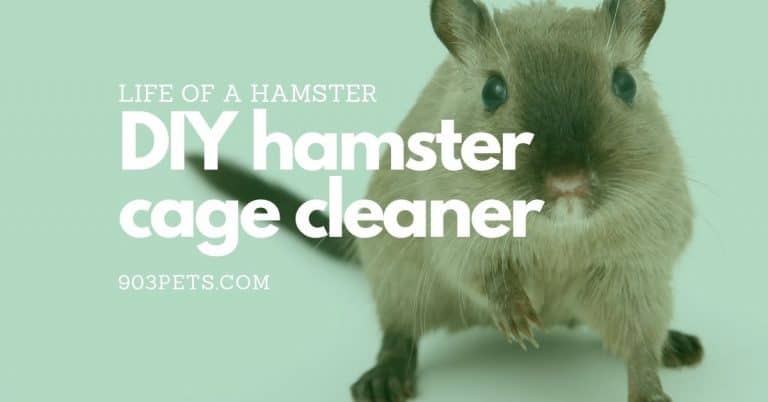
![The Ultimate Guide To Hamster Names [2021] 17 The Ultimate Guide To Hamster Names [2021]](https://cdn-0.903pets.com/ifywhoft/2021/09/The-Ultimate-Guide-To-Hamster-Names-2021-768x402.jpg)
![What Do Hamsters Eat [Do's and Don'ts] 19 What Can Hamster Eat Dos and Donts](https://cdn-0.903pets.com/ifywhoft/2022/01/What-Can-Hamster-Eat-Dos-and-Donts-768x402.jpg)